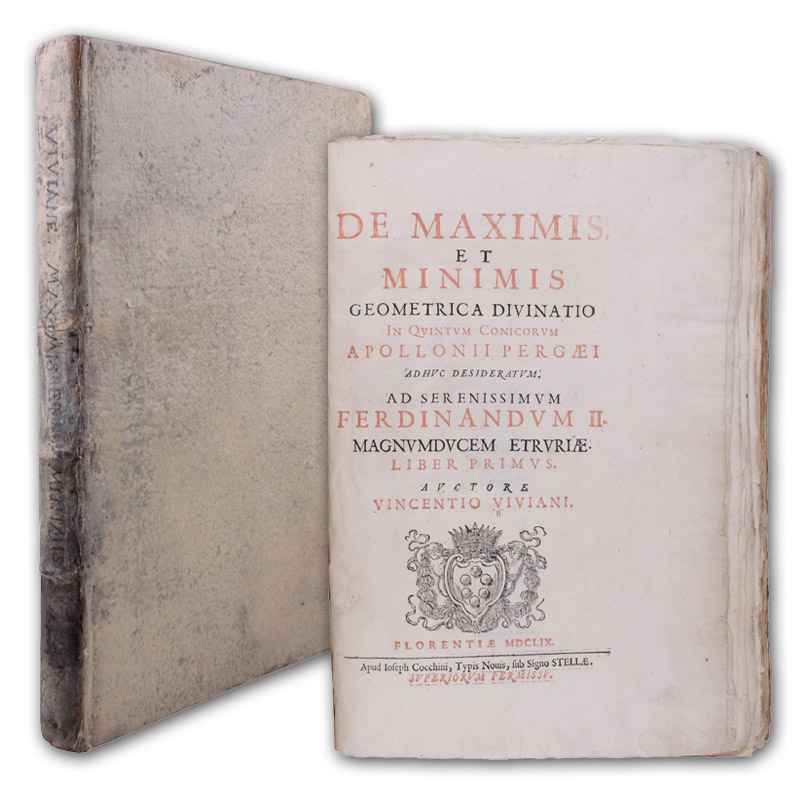100834-02
De maximis et minimis geometrica divinatio in quintum conicorum Apollonii Pergaei adhuc desideratum. 2 Teile in 1 Band.
Florenz, Cocchin, 1659. - (33,5 x 23 cm). (16) 154 S.; (4) 154 (2) S. Mit 2 Kupfern auf einer gefalteten Tafel, 2 zusammengesetzten Holzschnitt-Tafeln und zahlreichen Text-Holzschnitten. Interims-Pappband, unbeschnitten.
Erste Ausgabe dieses klassischen Werkes der analytischen Geometrie, das Erstlingswerk des Galilei-Schülers. Hier löst er u.a. das von Fermat gestellte Problem über gleichseitige Dreiecke, das zum "Satz von Viviani" führt. - "Another restoration of a Greek text by Viviani is interesting for a number of reasons. This was his restoration of the fifth book of Apollonius's Conics... By 1656 Viviani's work was quite close to completion when Giovanni Alfonso Borelli... discovered an Arabic version of the first seven books of Apollonius's Conics... Borelli took the manuscript to Rome where it was translated into Latin by Abrahamus Ecchellensis. In 1659 both the translation from the Arabic and Viviani's restoration were published. Viviani's work was entitled 'De maximis et minimis geometrica Divinatio' and was certainly written by him without any knowledge of the translation of Apollonius's work. It is interesting, of course, to see how faithfully Viviani was able to reconstruct Apollonius's book since now both the reconstruction and the original had become available. Viviani had done an excellent job, his biggest 'error' being that he had been able to penetrate deeper than Apollonius himself. The realisation that Viviani was, in some sense, a better geometer than the revered Apollonius, gave him instant fame throughout the centres of learning in Europe. His reputation as a mathematician was high throughout Europe" (MacTutor History of Mathematics archive). - Titel verso gestempelt. Rechte untere Ecke stellenweise mit sehr schwachem Fleckenrand. Eine der Holzschnitt-Tafeln leicht angeschnitten. Die Tafeln und ein Textblatt am Rand mit Notizen von alter Hand. Vorsätze erneuert. Insgesamt gut erhaltenes Exemplar. - DSB 14, 48; Riccardi I/2, 625: "Raro e pregiato"; Cinti 135
De maximis et minimis geometrica divinatio in quintum conicorum Apollonii Pergaei adhuc desideratum. 2 Teile in 1 Band.
Florenz, Cocchin, 1659. - (33,5 x 23 cm). (16) 154 S.; (4) 154 (2) S. Mit 2 Kupfern auf einer gefalteten Tafel, 2 zusammengesetzten Holzschnitt-Tafeln und zahlreichen Text-Holzschnitten. Interims-Pappband, unbeschnitten.
Erste Ausgabe dieses klassischen Werkes der analytischen Geometrie, das Erstlingswerk des Galilei-Schülers. Hier löst er u.a. das von Fermat gestellte Problem über gleichseitige Dreiecke, das zum "Satz von Viviani" führt. - "Another restoration of a Greek text by Viviani is interesting for a number of reasons. This was his restoration of the fifth book of Apollonius's Conics... By 1656 Viviani's work was quite close to completion when Giovanni Alfonso Borelli... discovered an Arabic version of the first seven books of Apollonius's Conics... Borelli took the manuscript to Rome where it was translated into Latin by Abrahamus Ecchellensis. In 1659 both the translation from the Arabic and Viviani's restoration were published. Viviani's work was entitled 'De maximis et minimis geometrica Divinatio' and was certainly written by him without any knowledge of the translation of Apollonius's work. It is interesting, of course, to see how faithfully Viviani was able to reconstruct Apollonius's book since now both the reconstruction and the original had become available. Viviani had done an excellent job, his biggest 'error' being that he had been able to penetrate deeper than Apollonius himself. The realisation that Viviani was, in some sense, a better geometer than the revered Apollonius, gave him instant fame throughout the centres of learning in Europe. His reputation as a mathematician was high throughout Europe" (MacTutor History of Mathematics archive). - Titel verso gestempelt. Rechte untere Ecke stellenweise mit sehr schwachem Fleckenrand. Eine der Holzschnitt-Tafeln leicht angeschnitten. Die Tafeln und ein Textblatt am Rand mit Notizen von alter Hand. Vorsätze erneuert. Insgesamt gut erhaltenes Exemplar. - DSB 14, 48; Riccardi I/2, 625: "Raro e pregiato"; Cinti 135
4.900 €

